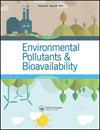Toxicity, bioaccumulation and biomagnification of silver nanoparticles in green algae (Chlorella sp.), water flea (Moina macrocopa), blood worm (Chironomus spp.) and silver barb (Barbonymus gonionotus)
Q3 Chemical Engineering
引用次数: 69
Abstract
Abstract The toxicity, bioaccumulation and biomagnification of material containing silver nanoparticles were studied in a model food chain. Two forms of silver namely, Ag+ and nano Ag° particles (AgNPs) were examined for their toxicity effects on Chlorella sp., Moina macrocopa, Barbonymus gonionotus and Chironomus spp. The results showed that the toxicity order on the four organisms was free Ag+> AgNPs. For toxicity of Ag+, the EC5° (effective concentration) was 0.39±0.32 mg L-1 for Chlorella sp. and the LC5° (lethal concentration) of M. macrocopa, B. gonionotus and Chironomus spp. were 0.026±0.43 mg L-1, 0.057±1.15 mg L-1, and 0.042±0.19 mg L-1, respectively. For toxicity, the EC5° of AgNPs was 0.89±0.68 mg L-1 for Chlorella sp. and the LC5° of M. macrocopa, B. gonionotusand Chironomus spp. were 1.11±0.86 mg L-1, 1.76±0.19 mg L-1, and 1.08±1.21 mg L-1, respectively. The results of the bioaccumulation study indicated that the highest bioaccumulation factor (BAF) of Ag+ was 101.84 L g-1 in Chlorella sp. and the lowest BAF of AgNPs was 1.89 L g-1 in B. gonionotus. The food chain transfer of AgNPs occurred only from Chlorella sp. to M. macrocopa and there was no evidence of biomagnification from food sources to consumers in a simple tropical food chain.纳米银颗粒在绿藻(Chlorella sp.)、水蚤(Moina macrocopa)、血虫(Chironomus spp.)和银倒刺(Barbonymus gonionotus)中的毒性、生物蓄积和生物放大作用
摘要在模拟食物链中研究了含银纳米粒子材料的毒性、生物蓄积和生物放大作用。研究了银离子(Ag +)和纳米银离子(AgNPs)对小球藻(Chlorella sp., Moina macrocopa)、gonionotus (Barbonymus gonionotus)和Chironomus sp.的毒性作用,结果表明,银离子对四种生物的毒性顺序为游离Ag+> AgNPs。Ag+对小球藻的EC5°(有效浓度)为0.39±0.32 mg L-1,对大螯虾、黄颡鱼和绒螯虾的LC5°(致死浓度)分别为0.026±0.43 mg L-1、0.057±1.15 mg L-1和0.042±0.19 mg L-1。在毒性方面,AgNPs对小球藻的EC5°为0.89±0.68 mg L-1,对大螯虾、黄颡鱼和Chironomus的LC5°分别为1.11±0.86 mg L-1、1.76±0.19 mg L-1和1.08±1.21 mg L-1。生物积累研究结果表明,小球藻中Ag+的最高生物积累因子(BAF)为101.84 L g-1,阴离子芽孢杆菌中AgNPs的最低BAF为1.89 L g-1。AgNPs的食物链转移仅发生在小球藻(Chlorella sp.)到巨巨藻(m.m macrocopa)之间,没有证据表明在简单的热带食物链中存在从食物源到消费者的生物放大效应。
本文章由计算机程序翻译,如有差异,请以英文原文为准。
求助全文
约1分钟内获得全文
求助全文
来源期刊
CiteScore
1.62
自引率
0.00%
发文量
0
审稿时长
1 months
期刊介绍:
Chemical Speciation & Bioavailability ( CS&B) is a scholarly, peer-reviewed forum for insights on the chemical aspects of occurrence, distribution, transport, transformation, transfer, fate, and effects of substances in the environment and biota, and their impacts on the uptake of the substances by living organisms. Substances of interests include both beneficial and toxic ones, especially nutrients, heavy metals, persistent organic pollutants, and emerging contaminants, such as engineered nanomaterials, as well as pharmaceuticals and personal-care products as pollutants. It is the aim of this Journal to develop an international community of experienced colleagues to promote the research, discussion, review, and spread of information on chemical speciation and bioavailability, which is a topic of interest to researchers in many disciplines, including environmental, chemical, biological, food, medical, toxicology, and health sciences.
Key themes in the scope of the Journal include, but are not limited to, the following “6Ms”:
Methods for speciation analysis and the evaluation of bioavailability, especially the development, validation, and application of novel methods and techniques.
Media that sustain the processes of release, distribution, transformation, and transfer of chemical speciation; of particular interest are emerging contaminants, such as engineered nanomaterials, pharmaceuticals, and personal-care products.
Mobility of substance species in environment and biota, either spatially or temporally.
Matters that influence the chemical speciation and bioavailability, mainly environmentally relevant conditions.
Mechanisms that govern the transport, transformation, transfer, and fate of chemical speciation in the environment, and the biouptake of substances.
Models for the simulation of chemical speciation and bioavailability, and for the prediction of toxicity.
Chemical Speciation & Bioavailability is a fully open access journal. This means all submitted articles will, if accepted, be available for anyone to read, anywhere, at any time. immediately on publication. There are no charges for submission to this journal.

 求助内容:
求助内容: 应助结果提醒方式:
应助结果提醒方式:


